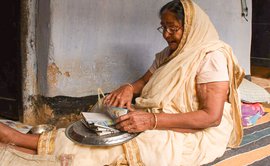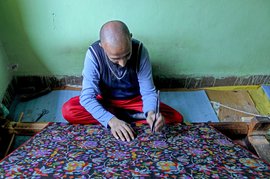Mohammad Shoaib’s shop is open 24x7, but if you want to get a taste of his special dish, you better arrive early in the morning.
The 35-year-old has been running the Heritage Harissa shop in the Grata Bal area in Nawakadal for 15 years. This neighbourhood in downtown Srinagar is the hub of harissa shops in the city, some of which are more than three centuries old. The story of the dish is even older.
“I have heard from my father that the craft of making harissa comes from Shah-i-Hamdan [a 14th century Sufi saint from Iran] who introduced it to the harissa -makers of the valley,” says Shoaib, a fourth generation harissa -maker.
The high-protein breakfast dish made with lamb and rice is available
only six months a year – from October to March – served hot with a side of
meethi
(minced lamb intestines) and
kebab sprinkled with hot oil and some
kander
czot
(local bread made with wheat flour) to wipe it all down. The spices that go into making the dish include
green and black cardamom, cinnamon, and clove. It is then cooked overnight in
mathh
(a copper or earthen pot) buried
in the earth, with a chamber of firewood below.


Left: Mohammad Shoaib runs one of the many harissa shops in downtown Srinagar. This winter breakfast is made with rice and meat, and cooked for over 16 hours. Shoaib is removing the fat from the mutton before putting it in the earthen pot to cook with Kashmir rice. Right: Mohammad Amin, who works in Shoaib's shop, is preparing meethi – lamb intestines with dried fenugreek – which will be served as a side


Oil is heated in a pan on high and poured over the dish . ' The tadka makes it tastier,' says Shoaib (right)
“I inherited the art of making harissa from my father,” says Shoaib, whose shop is an extension of his house where he lives with his mother, wife and two young daughters. The shop is also accessible through the kitchen of their three-storey house. Women here, however, play no part in the process of harissa -making. “If I have a son, I will pass on the trade to him,” Shoaib says. When not making and selling harissa , Shoaib runs a dry fruit and grocery store.
Since taking over from his father Mohammad Sultan, who passed away in 2022, Shoaib has expanded the business and renovated the shop, adding chairs and tables and fitting it with tiles. “I made it look modern because nowadays it is not just locals, but also tourists who come to eat harissa ,” he says while he cooks, standing in the kitchen of his shop.
Among the customers is Dr. Kamran, who travels from Hazratbal, around eight kilometres away, just to have the harissa at Shoaib’s shop. “The harissa here tastes wonderful, I come here whenever I have money in my pocket,” says the 42-year-old, “I have even sent it to my friend in Saudi Arabia!” A plate of harissa here is priced at Rs. 1,200.
Shoaib begins to serve the
harissa
at 7 a.m. in copper plates, traditionally designed with
motifs of
chinar
leaves. By 10 a.m,
the large copper pot in which the
harissa
is made is empty. “Three years ago, I sold 75 kilograms in one day!” he
recalls.


Left
: Ishfaq (left) and his uncle Mohammad Munawar (right) work at the 350-year-old Big Choice Harissa Shop. It is located in the Aali Kadal area in downtown Srinagar, and run by Fayaz Ahmad.
Right: Mohammad Munawar holding a tray of
praan
(fried
shallots). 'Without
praan
one cannot even think of making a tasty
harissa
,' he says


Left: Ishfaq setting up the chimney. He will then light a fire in the chamber where the earthen pot of harissa will be placed. Right: Fayaz packing harissa for a customer
But even after the food is sold out, Shoaib’s work is not done: “As soon as the pot is empty, we have to start the process all over again.”
The process starts with getting the meat from the local butcher, priced at Rs. 650-750 a kilo, which is chopped into pieces, the fat removed. “Then the process of boiling top quality Kashmiri rice begins and we have to cook it until it turns into a paste. Next, we put the mutton into the rice paste and cook it on a high flame for six to seven hours and then add spices and water as required,” says Shoaib, who has two employees to help him.
“There is no secret spice that goes into making a delicious harissa ,” he continues, “from carefully selecting the right mutton to removing the fat and choosing the best quality spices, I have to spend almost 16 hours gently stirring the mixture to achieve the right consistency and taste.”
“Making the
harissa
is no easy task,” says Shoaib.


Left: Shoaib decorates the hot harissa platter with meethi for the customers. Right A copper vessel full of harissa with meethi is being prepared for a wedding in Srinagar. Harissa is a staple in winter weddings and it is customary for the groom to send a pot to the bride's family




